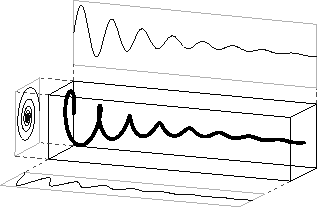NOTE: THIS DOCUMENT IS OBSOLETE, PLEASE CHECK THE NEW VERSION: "Mathematics of the Discrete Fourier Transform (DFT), with Audio Applications --- Second Edition", by Julius O. Smith III, W3K Publishing, 2007, ISBN 978-0-9745607-4-8. - Copyright © 2017-09-28 by Julius O. Smith III - Center for Computer Research in Music and Acoustics (CCRMA), Stanford University
<< Previous page TOC INDEX Next page >>
Powers of
Choose any two complex numbers
and
, and form the sequence
What are the properties of this signal? Expressing the two complex numbers as
we see that the signalis always a discrete-time generalized complexsinusoid, i.e., an exponentially enveloped complex sinusoid.
Figure 5.9 shows a plot of a generalized (exponentially decaying) complex sinusoid versus time.
Note that the left projection (onto the
plane) is a decaying spiral, the lower projection (real-part vs. time) is an exponentially decaying cosine, and the upper projection (imaginary-part vs. time) is an exponentially enveloped sine wave.

